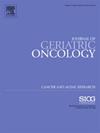Frailty predicts treatment-related toxicity and discontinuation in older adults with chronic lymphocytic leukemia treated with BTK and BCL-2 inhibitors: Findings from a prospective single-center cohort study
IF 3
3区 医学
Q3 GERIATRICS & GERONTOLOGY
引用次数: 0
Abstract
Introduction
Chronic lymphocytic leukemia (CLL) particularly impacts older adults with multiple comorbidities. The advent of targeted therapies has improved outcomes, but challenges related to treatment adherence and drug interactions persist. Assessment of frailty is recommended to tailor treatment, though its application in clinical settings is often limited due to its complexity. This study aimed to investigate the predictive value of frailty regarding treatment toxicity and discontinuation in older patients with CLL treated with targeted therapies.
Materials and Methods
This prospective cohort study involved 82 older adults with CLL (≥65 years) treated with Bruton's tyrosine kinase inhibitors (BTKi) or BCL-2 inhibitors (BCL-2i) from November 2018 to February 2024. Patients were assessed by the Canadian Study of Health and Aging (CSHA) Clinical Frailty Scale (CFS) within a week before starting treatment. Demographics, CLL characteristics, comorbidities, and treatment-related adverse events were collected. Statistical analyses included receiver operating characteristic (ROC) curve analysis to determine the optimal cut-off for predicting treatment discontinuation due to toxicity.
Results
The median age of patients was 75 years. Most patients (90.2 %) were at Binet stage B/C, with 14.6 % having 17p deletion and 17.1 % TP53 mutations. Overall, 46 patients experienced treatment-related toxicity. The ROC curve analysis showed that the best cut-off for predicting treatment-related toxicity was a CSHA CFS >3. The accuracy was fair, with an area under the curve (AUC) of 0.695 (95 % CI 0.55–0.84; P = 0.02), sensitivity = 85 % and specificity = 53 %. Patients with a score > 3 experienced higher rates of treatment discontinuation (28.6 %) compared to those with a score ≤ 3 (12.5 %; P < 0.05). Other factors such as polypharmacy, cumulative illness rating, and comorbidity indices did not significantly affect treatment discontinuation rates.
Discussion
The CSHA CFS is a feasible tool for identifying older adults with CLL at higher risk of treatment toxicity and discontinuation. Patients with a CFS >3 had a significantly higher likelihood of treatment interruption due to adverse effects. Therefore, CSHA CFS can aid in stratifying patients and optimizing therapeutic strategies. Further validation in multicenter studies is warranted to confirm these results and explore the potential for adjusting treatment dosages based on frailty assessments in the era of targeted therapies.
BTK和BCL-2抑制剂治疗的老年慢性淋巴细胞白血病患者虚弱预示着治疗相关的毒性和停药:来自一项前瞻性单中心队列研究的发现
慢性淋巴细胞白血病(CLL)特别影响具有多种合并症的老年人。靶向治疗的出现改善了结果,但与治疗依从性和药物相互作用相关的挑战仍然存在。虚弱评估被推荐用于定制治疗,尽管其在临床环境中的应用往往由于其复杂性而受到限制。本研究旨在探讨衰弱对接受靶向治疗的老年CLL患者治疗毒性和停药的预测价值。材料和方法本前瞻性队列研究纳入了2018年11月至2024年2月期间接受布鲁顿酪氨酸激酶抑制剂(BTKi)或BCL-2抑制剂(BCL-2i)治疗的82名CLL老年患者(≥65岁)。患者在开始治疗前一周内采用加拿大健康与衰老研究(CSHA)临床虚弱量表(CFS)进行评估。收集了人口统计学、CLL特征、合并症和治疗相关不良事件。统计分析包括受试者工作特征(ROC)曲线分析,以确定预测因毒性而停止治疗的最佳截止值。结果患者中位年龄为75岁。大多数患者(90.2%)为Binet B/C期,其中14.6%的患者有17p缺失,17.1%的患者有TP53突变。总的来说,46名患者出现了治疗相关的毒性。ROC曲线分析显示,预测治疗相关毒性的最佳截止点是CSHA CFS [gt;3]。准确度较好,曲线下面积(AUC)为0.695 (95% CI 0.55-0.84;P = 0.02),敏感性为85%,特异性为53%。评分患者>;3分患者的停药率(28.6%)高于评分≤3分患者(12.5%;P & lt;0.05)。其他因素如多药、累积疾病分级和合并症指数对停药率没有显著影响。CSHA CFS是一种可行的工具,用于识别治疗毒性和停药风险较高的老年CLL患者。患有CFS的患者因不良反应而中断治疗的可能性明显更高。因此,CSHA CFS可以帮助患者分层和优化治疗策略。有必要在多中心研究中进一步验证这些结果,并探索在靶向治疗时代根据脆弱性评估调整治疗剂量的潜力。
本文章由计算机程序翻译,如有差异,请以英文原文为准。
求助全文
约1分钟内获得全文
求助全文
来源期刊

Journal of geriatric oncology
ONCOLOGY-GERIATRICS & GERONTOLOGY
CiteScore
5.30
自引率
10.00%
发文量
379
审稿时长
80 days
期刊介绍:
The Journal of Geriatric Oncology is an international, multidisciplinary journal which is focused on advancing research in the treatment and survivorship issues of older adults with cancer, as well as literature relevant to education and policy development in geriatric oncology.
The journal welcomes the submission of manuscripts in the following categories:
• Original research articles
• Review articles
• Clinical trials
• Education and training articles
• Short communications
• Perspectives
• Meeting reports
• Letters to the Editor.
 求助内容:
求助内容: 应助结果提醒方式:
应助结果提醒方式:


